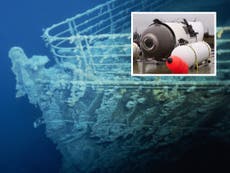He went on OceanGate’s Titanic sub with its CEO. Only now does he realise how dangerous it was
David Waud visited the Titanic wreckage in 2021 with OceanGate, traveling with Stockton Rush on the now-missing submersible Titan. He tells Sheila Flynn: ‘I don’t know what they’re going to find’

Your support helps us to tell the story
From reproductive rights to climate change to Big Tech, The Independent is on the ground when the story is developing. Whether it's investigating the financials of Elon Musk's pro-Trump PAC or producing our latest documentary, 'The A Word', which shines a light on the American women fighting for reproductive rights, we know how important it is to parse out the facts from the messaging.
At such a critical moment in US history, we need reporters on the ground. Your donation allows us to keep sending journalists to speak to both sides of the story.
The Independent is trusted by Americans across the entire political spectrum. And unlike many other quality news outlets, we choose not to lock Americans out of our reporting and analysis with paywalls. We believe quality journalism should be available to everyone, paid for by those who can afford it.
Your support makes all the difference.An underwater filmmaker who journeyed to the depths of the ocean in 2021 on the now-missing submersible Titan — relying on regular communications for guidance — has described how “terrifying” it would be on the tiny vehicle where “you are really alone down there.”
David Waud, of Chicago, realised a long-term dream when, after decades of underwater filmmaking and photography, he joined the OceanGate expedition alongside its CEO and fellow Princeton alum Stockton Rush — one of the five Titan crew members currently unaccounted for. Communications with the submersible were lost less than two hours after it began its dive on Sunday, and international search and rescue teams are fighting the clock to find it before the crew’s oxygen runs out.
“My first thought was it had imploded, and that’s why they lost communication,” he told The Independent on Wednesday. “Now they have these banging noises, but there are always noises in the ocean, too. So I don’t know what they’re going to find.”
He says he expected teams to “keep looking ... for the next few weeks, I would say, to at least try to find the submersible and what’s left of it.”
Follow the latest updates on the missing Titanic submarine here
Mr Waud, who spent years making underwater movies and showing presentations in schools, filmed his own journey to the Titanic — where he spotted the stern — and intended to use the footage to produce a film project for charity.
“I was going to make a movie, which I have not done and now think would be in poor taste, about my trip down to see Titanic,” he says.
He believed that a miracle rescue “would be in the next 12 hours or whatever ... I can’t imagine.”

“I’m hoping it imploded,” he said of the more merciful of possibilities, adding: “I mean, you really would not know what happens — what can happen in a split second.”
Confirmed on Titan are Mr Rush; British billionaire explorer Hamish Harding; renowned French diver Paul-Henri Nargeolet; and Pakistani businessman Shahzada Dawood and his 19-year-old son, Suleman Dawood.
Following their own journey to Titanic in 2021, Mr Rush and Mr Nargeolet joined Mr Waud in his hometown of Chicago to show off Titan to hundreds and give a presentation about the exploration.
“I respected him so much and what he had done with that company [to] make this possible for not just researchers and scientists to go down,” Mr Waud says of fellow Princetonian Mr Rush, explaining that the CEO had majored in aeronautical engineering at the university but “kind of went the other direction” — under the sea.
Pointing out that the expedition coincided with his own personal and career interests, he said: “I was not just what they call a wealthy tourist, and I didn't pay as much as they're quoting, either, because I signed up quite a few years ago when it was a little bit less.”
“He’s done such a great job with it,” he says of Mr Rush. “And obviously, he wouldn't have been down there piloting it almost every single trip, every single dive, if he hadn't had 100 per cent confidence that submersible was okay.”
Mr Waud had no qualms himself about going down on Titan in August 2021, despite the fact that only two of the three dive groups during his trip were able to make the very weather-dependent journey to the wreckage.
“I felt so safe on this particular trip,” he says. “I do not get claustrophobia easily, so I didn't feel any problems when I was down there for 11 hours, between 10 and 11 hours. But to think of being stuck in that submersible for four days, and not knowing what's going to happen, is just a terrifying thought for everybody.”
Mr Waud witnessed firsthand just how reliant Titan and its crew were on communications and technology.
“You don't feel going down,” he says, taking issue with a description he’d read of the descent as “sinking like a rock. “I figured out you're going one mile an hour ... I think a rock would go maybe faster than that,” he says. “So you don't feel it; it is dark outside, and then you get to this one zone and you see the phosphorescence in the water for a few minutes, and then it gets dark again.”
He explained how “they communicate all the way down ... telling you what direction you’re going. Every 15 minutes, you get a communication, how fast you’re sinking, how deep you are, and what quadrant you’re in.”
The communication remains when the submersible nears the bottom, he said.

“All that silt goes up around you for about five minutes ... and then it settles, and then they put on the forward thrusters, and we start moving, but we didn't know where we were,” he told The Independent. “We were in the debris field, but we didn't know what we were near. And then we would get the signals from from the support boat, the communications team, which direction to go –and we were much closer to the stern.
“And so it took a while to find the stern, because the stern is really unrecognisable – I almost don't think of it as part of the Titanic,” he says. “It's just not what you think of when you hear and see images of the Titanic. But it actually was fascinating, because it was so crumpled up.”
He continues: “One of the motors for the one of the propellers is one of the recognizable things that you can see there; it's called a reciprocating motor for one of the side propellers, I think. So once we thought, ‘We're only a few feet away’ – at least it looks like it in my videos – we're only a few feet away from the wreckage. We were not too far from the propellers, and they don't want to go down to the propellers, because there's part of the ship hanging over you, when you go to the propellers – it's not a straight down in the back.
“And they never wanted to go anywhere where you had something over you, where you couldn't go straight back up if you needed to. So we found about where the propellers were going to be, if we had gotten closer, but they're very safety conscious. Obviously Stockton is the pilot.”
Mr Waud had been attempting to visit the Titanic wreckage since at least 2010, pursuing various unsuccessful avenues before hitting upon OceanGate in 2019.
“I signed up and thought I might be going, and that did not turn out because Titan, they just didn't have enough time to test it at depth before those trips – and then, actually, it was reinforced the next year,” he said. “They added a lot more to it, because they found, even though it could go that deep, It couldn't do it time after time after time. There was some cumulative effect on it. So they did an awful lot of work on it again, during the pandemic, in 2020. And I was on the fifth mission, the final mission of the summer in 2021.”
Mr Waud, however, said he’s been “surprised” by “everything I've been reading about it not being certified.”

“I think I probably knew that,” he said. “I don't know if the word ‘experimental’ is in that first page of the release that you have to sign.”
He said that Mr Rush “was proud of that, that he could control that sub with a little PlayStation game console, because it goes up and down on its own by weight and buoyancy ... there are four thrusters.”
When he, Mr Rush and Mr Nargeolet showed off Titan in Chicago, Mr Waud says, many of those who came to see the submersible – including his friends and family – “couldn’t imagine being inside Titan for 11 hours like I was.”
Regarding his wife and children, he says, “I don't know how nervous they were when I was on it, but they now know that it was a lot more dangerous than I thought it was and that I made it out to be .
“Nobody who’d been to the Titanic has ever been injured before or, as Stockton said in one of his interviews, in 35 years of submersibles going down to do research and things. ... nobody has been injured,” Mr Waud said. “So there’s always a first, and I'm afraid this is it.”
But Mr Waud – and his family – remain adamant about the need for and benefits of further scientific exploration.
“These trips remind us of how little we known about the ocean; how we are still no match for Mother Nature,” his daughter, Dana Waud Floberg – who serves on the auxiliary board of Chicago’s Shedd Aquarium – wrote on Wednesday. “If we want to continue to learn, we must continue to take risks. That’s how we first found the Titanic, first summited Everest, and first made it into space. Let’s celebrate the lives of those who took a chance so that one day we may all be able to easily explore the ocean. Who knows what we’ll find.”



Join our commenting forum
Join thought-provoking conversations, follow other Independent readers and see their replies
Comments